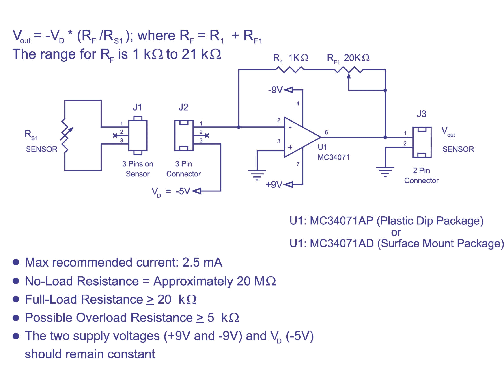Flexiforce Pressure
Sensors
 Flexiforce pressure sensors can measure force
between almost any two surfaces and is durable enough to stand up to most
environments. Flexiforce has better sensor properties, linearity,
hysteresis, drift and temperature sensitivity than any other thin film
force sensor.
Flexiforce pressure sensors can measure force
between almost any two surfaces and is durable enough to stand up to most
environments. Flexiforce has better sensor properties, linearity,
hysteresis, drift and temperature sensitivity than any other thin film
force sensor.
Typical Sensor Response:

The Flexiforce single element sensor acts
as a resistor in an electrical circuit. When the sensor is unloaded,
its resistance is very high. When a force is applied to the sensor,
this resistance decreases. The resistance can be read by connecting
an ohm meter to the outer two pins of the sensor connector and applying
a force to the sensing area.
There are many ways to integrate the sensor
into an application. One way is to incorporate it into a force-to-voltage
circuit. A means of calibration must be established to convert the
output into the appropriate engineering units. Depending on the setup,
an adjustment could then be done to increase or decrease the sensitivity
of the sensor.
Physical Properties:
-
Thickness: 0.005" (0.127 mm)
-
Length: 8.000" (203 mm) - End of connector
to tip of sensor
-
Width: 0.55" (14 mm)
-
Active Sensing Area: 0.375" (10 mm) diameter
-
Connector: 3 pin Berg Clincher
Standard Force Ranges:
(as tested with circuit shown below)
-
PS-01: 0 - 1 lb. (4.4 N)
-
PS-02: 0 - 25 lb. (111 N)
-
PS-03: 0 - 1000 lb. (4448 N)

Typical Performance:
-
Linearity (Error): < ±5% (Line drawn
from 0 to 50% load)
-
Repeatability: < ±2.5% of full scale
(Conditioned sensor, 80% of full force applied)
-
Hysteresis: < ±4.5% of full scale
(Conditioned sensor, 80% of full force applied)
-
Drift: < 3% / logarithmic time (Constant
load - 25 lb.)
-
Rise Time: < 20 µsec (Impact load
- recorded on oscilloscope)
-
Operating Temperature: 15º F - 140º
F (-9º C - 60º C)*
* Force reading change per degree of temperature
changing = ±0.2% / ºF (0.36% / ºC)
* For loads less than 10 lb., the operating
temperature can be increased to 165º F (74º C)
Applications:
-
To measure contact between any two mating
surfaces.
-
As a variable force control for computer game
joysticks.
-
As a measurement device in mechanical assemblies
(e.g. to measure clamp load from a tightening bolt).
-
As a force probe when laminated to a shim
stock.
-
To measure weight distribution when attached
to the four corners of a floor panel.
-
To measure forces from explosions and crash
tests.
-
As a design tool to measure proper fit.
-
To measure grip on steering wheels / bicycle
handle bars.
-
As a force monitor when palpating a patient.
-
As a virtual reality force sensor in gloves.
-
To detect seat occupancy.
-
As a variable control switch for automotive,
process control, and recreational game manufacturers.
-
To measure fill rate and pressure when inserted
into molds.
-
As a physical rehabilitation force feedback
mechanism.
Return to Catalog
Page
| Images SI
Inc. Home | Online Catalog | Sensors
| Order Form
|



